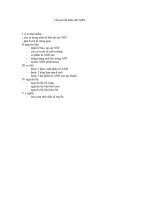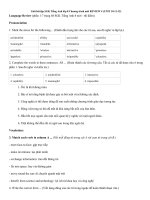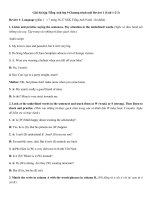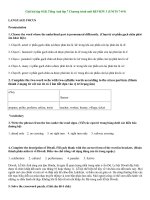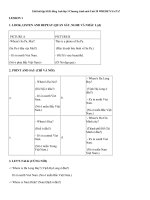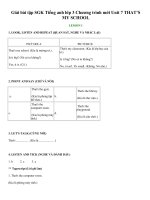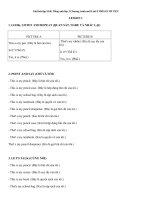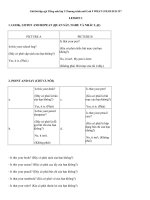Tiếng anh chuyên ngành kế toán part 5
Bạn đang xem bản rút gọn của tài liệu. Xem và tải ngay bản đầy đủ của tài liệu tại đây (105.85 KB, 10 trang )
28
Understanding the Numbers
USING FINANCIAL RATIOS
Some important points to keep in mind when using financial ratios are:
• Whereas all balance sheet numbers are end-of-period numbers, all in-
come statement numbers relate to the entire period. For example, when
calculating the ratio for Accounts Receivable Turnover, we use a numera-
tor of Credit Sales, which is an entire-period number from the income
statement, and a denominator of Accounts Receivable, which is an end-of-
period number from the balance sheet. To make this an apples-to-apples
ratio, the Accounts Receivable can be represented by an average of the
beginning-of-year and end-of-year figures for Accounts Receivable. This
average is closer to a mid-year estimate of Accounts Receivable and there-
fore is more comparable to the entire-period numerator, Credit Sales. Be-
cause using averages of the beginning-of-year and end-of-year figures for
balance sheet numbers helps to make ratios more of an apples-to-apples
EXHIBIT 1.1 Summary of main financial ratios.
Ratio Numerator Denominator
Short-Term Liquidity
Current ratio Current assets Current liabilities
Quick ratio (acid test) Current assets Current liabilities
(excluding inventory)
Receivables turnover Credit sales Accounts receivable
Inventory turnover Cost of sales Inventory
Payables turnover Cost of sales Accounts payable
Long-Term Solvency
Interest coverage EBIT Interest on L/T debt
Debt to capital Long-term debt L/T debt + equity
Profitability on Sales
Gross profit ratio Gross profit Sales
Operating expense ratio Operating expenses Sales
SG&A expense ratio SG&A expenses Sales
EBIT ratio EBIT Sales
Pretax income ratio Pretax income Sales
Net income ratio Net income Sales
Profitability on Investment
Return on total assets:
Before tax EBIT Total assets
a
After tax EBIT times (1-tax rate) Total assets
a
Return on equity Net income: Common
b
Common equity
a
Total Assets = Fixed Assets + Working Capital (Current Assets less Current Liabilities)
b
Net Income less Preferred Dividends
Using Financial Statements
29
comparison, averages should be used for all balance sheet numbers when
calculating financial ratios.
• Financial ratios can be no more reliable than the data with which the ra-
tios were calculated. The most reliable data is from audited financial
statements, if the audit reports are clean and unqualified.
• Financial ratios cannot be fully considered without yardsticks of compar-
ison. The simplest yardsticks are comparisons of an enterprise’s current
financial ratios with those from previous periods. Companies often pro-
vide this type of information in their financial reporting. For example,
Apple Computer Inc., recently disclosed the following financial quarterly
information, in millions of dollars:
Quarter 4 3 2 1
Net sales $1,870 $1,825 $1,945 $2,343
Gross margin $1,122 $1,016 $1,043 $1,377
Gross margin 25% 30% 28% 28%
Operating costs $ 383 $ 375 $ 379 $ 409
Operating income $ 64 $ 168 $ 170 $ 100
Operating income 4% 9% 9% 4%
This table compares four successive quarters of information, which
makes it possible to see the latest trends in such important items as Sales,
and Gross Margin and Operating Income percentages. Other types of
comparisons of financial ratios include:
1. Comparisons with competitors. For example, the financial ratios of
Apple Computer could be compared with those of Compaq, Dell, or
Gateway.
2. Comparisons with industry composites. Industry composite ratios can
be found from a number of sources, such as:
a. The Almanac of Business and Industrial Financial Ratios, au-
thored by Leo Troy and published annually by Prentice-Hall (Para-
mus, NJ). This publication uses Internal Revenue Service data for
4.6 million U.S. corporations, classified into 179 industries and di-
vided into categories by firm size, and reporting 50 different fi-
nancial ratios.
b. Risk Management Associates: Annual Statement Studies. This is a
database compiled by bank loan officers from the financial state-
ments of more than 150,000 commercial borrowers, representing
more than 600 industries, classified by business size, and reporting
16 different financial ratios. It is available on the Internet at
www.rmahq.org.
c. Financial ratios can also be obtained from other firms who special-
ize in financial information, such as Dun & Bradstreet, Moody’s,
and Standard & Poor’s.
30
Understanding the Numbers
COMBINING FINANCIAL RATIOS
Up to this point we have considered financial ratios one at a time. However,
there is a useful method for combining financial ratios known as Dupont
1
analysis. To explain it, we first need to define some financial ratios, together
with their abbreviations, as follows:
Ratio Calculation Abbreviation
Profit margin
2
Net income/sales NI/S
Asset turnover Sales/total assets S/TA
Return on assets
3
Net income/total assets NI/TA
Leverage Total assets/common equity TA /CE
Return on equity Net income/common equity NI/CE
Now, these financial ratios can be combined in the following manner:
and
In summary:
This equation says that Profit Margin × Asset Turnover × Leverage = Return
on Equity.
Also, this equation provides a financial approach to business strategy. It
recognizes that the ultimate goal of business strategy is to maximize stock-
holder value, that is, the market price of the common stock. This goal requires
maximizing the return on common equity. The Dupont equation above breaks
the return on common equity into its three component parts: Profit Margin
(Net Income/Sales), Asset Turnover (Sales/Total Assets), and Leverage (Total
Assets/Common Equity). If any one of these three ratios can be improved
(without harm to either or both of the remaining two ratios), then the return
on common equity will increase. A firm thus has specific strategic targets:
• Profit Margin improvement can be pursued in a number of ways. On the
one hand, revenues might be increased or costs decreased by:
N1
S
S
TA
TA
CE
N1
CE
××=
Return on Assets Leverage Return on Equity
Net Income
Total Assets
Total Assets
Common Equity
Net Income
Common Equity
×=
×=
Profit Margin Asset Turnover Return on Assets
Net Income
Sales
Sales
Total Assets
Net Income
Total Assets
×=
×=
Using Financial Statements
31
1. Raising prices perhaps by improving product quality or offering extra
services. Makers of luxury cars have done this successfully by provid-
ing free roadside assistance and loaner cars when customer cars are
being serviced.
2. Maintaining prices but reducing the quantity of product in the pack-
age. Candy bar manufacturers and other makers of packaged foods
often use this method.
3. Initiating or increasing charges for ancillary goods or services. For ex-
ample, banks have substantially increased their charges to stop checks
and for checks written with insufficient funds. Distributors of com-
puters and software have instituted fees for providing technical assis-
tance on their help lines and for restocking returned items.
4. Improving the productivity and efficiency of operations.
5. Cutting costs in a variety of ways.
• Asset Turnover may be improved in ways such as:
1. Speeding up the collection of accounts receivable.
2. Increasing inventory turnover, perhaps by adopting “just in time” in-
ventory methods.
3. Slowing down payments to suppliers, thus increasing accounts payable.
4. Reducing idle capacity of plant and equipment.
• Leverage may be increased, within prudent limits, by means such as:
1. Using long-term debt rather than equity to fund additions to plant,
property, and equipment.
2. Repurchasing previously issued common stock in the open market.
The chief advantage of using the Dupont formula is to focus attention on
specific initiatives that will improve return on equity by means of enhancing
profit margins, increasing asset turnover, or employing greater financial lever-
age within prudent limits.
In addition to the Dupont formula, there is another way to combine fi-
nancial ratios, one that serves another useful purpose—predicting solvency or
bankruptcy for a given enterprise. It uses what is known as the z score.
THE Z SCORE
Financial ratios are useful not only to assess the past or present condition of
an enterprise, but also to reliably predict its future solvency or bankruptcy.
This type of information is of critical importance to present and potential
creditors and investors. There are several different methods of analysis for
obtaining this predictive information. The best-known and most time-tested
is the z score, developed for publicly traded manufacturing firms by Professor
32
Understanding the Numbers
Edward Altman of New York University. Its reliability can be expressed in
terms of the two types of errors to which all predictive methods are vulner-
able, namely:
1. Type I error: predicting solvency when in fact a firm becomes bankrupt
(a false positive).
2. Type II error: predicting bankruptcy when in fact a firm remains solvent
(a false negative).
The predictive error rates for the Altman z score have been found to be as
follows:
Years Prior to % False % False
Bankruptcy Positives Negatives
163
2186
Given the inherent difficulty of predicting future events, these error rates are
relatively low, and therefore the Altman z score is generally regarded as a rea-
sonably reliable bankruptcy predictor. The z score is calculated from financial
ratios in the following manner:
A z score above 2.99 predicts solvency; a z score below 1.81 predicts bank-
ruptcy; z scores between 1.81 and 2.99 are in a gray area, with scores above
2.675 suggesting solvency and scores below 2.675 suggesting bankruptcy.
Since the z score uses equity at market value, it is not applicable to pri-
vate firms, which do not issue marketable securities. A variation of the z score
for private firms, known as the z′ score, has been developed that uses the book
value of equity rather than the market value. Because of this modification, the
multipliers in the formula have changed from those in the original z score, as
have the scores that indicate solvency, bankruptcy, or the gray area. For non-
manufacturing service-sector firms, a further variation in the formula has
been developed. It omits the variable for asset turnover and is known as the z′′
score. Once again, the multipliers in the formula have changed from those in
the z′ score, and so have the scores that indicate solvency, bankruptcy, or the
gray area.
Professor Altman later developed a bankruptcy predictor more refined
than the z score and named it ZETA. ZETA uses financial ratios for times in-
terest earned, return on assets (the average and the standard deviation), and
debt to equity. Other details of ZETA have not been made public. ZETA is
proprietary and is made available to users for a fee.
z = × +× +×
+× +×
12 14 33
06 10
. . .
. .
Working Capital
Total Assets
Retained Earnings
Total Assets
EBIT
Total Assets
Equity at Market Value
Debt
Sales
Total Assets

